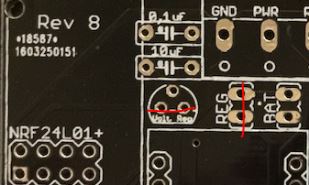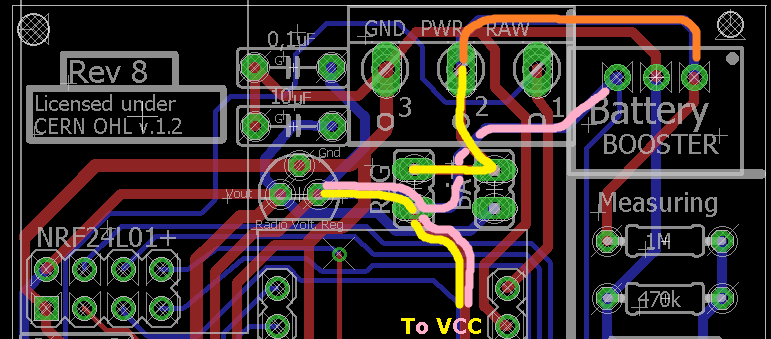Easy/Newbie PCB for MySensors
-
@Lior-Rubin - 3 batches from china, link in mysensor store - worked great for me.
-
Hi, I have received the PCBs, it is good help.
(3.3v mini with battery powering)
I have wiring problem. How could I connect radio's power input to boosted powering source to get stable 3.3v?
thanks@Barna see the instructions for "Regulated 5V" and "6-12v to RAW pin" on https://goo.gl/1ZMlUf https://www.openhardware.io/view/4/EasyNewbie-PCB-for-MySensors
-
@Barna Exaclty as @mfalkvidd said - use regulated power instructions instead.
Set the jumper on "reg" and bypass the voltage converter with a wire.Whats good to know is that this has been tested over and over in this forum and the conclusion has been so far that if you run with 2xAA the best sollution is to bypass the radio in the booster (i.e. use battery instructions - hence the difference). The radio can handle down to 1.9v so it wont die for a long time if you have some power savings in use.
-
@Barna Exaclty as @mfalkvidd said - use regulated power instructions instead.
Set the jumper on "reg" and bypass the voltage converter with a wire.Whats good to know is that this has been tested over and over in this forum and the conclusion has been so far that if you run with 2xAA the best sollution is to bypass the radio in the booster (i.e. use battery instructions - hence the difference). The radio can handle down to 1.9v so it wont die for a long time if you have some power savings in use.
@sundberg84 yes, I would like to use 2xAA. I have measured it, 2xAA's out is 2.6V, after booster it is 3.3 .
My first tying was battery jumper, but I had was radio problems.
After bypassed the volt reg part to give 3.3v.
When you have mentioned this : "Set the jumper on "reg" and bypass the voltage converter with a wire." do you talk about the jumper which next to battery jumper or the 2nd? I have tried which is next to radio.
I have a filling, it will be soldering or hw issue, because both has worked, and has not sometimes.
thanks -
@barna - what was the radio problem? If it was range issues i have figured out that some boosters are bad quality but it helps to have a 0,1uF capacitor between out and gnd on the booster.
Note that you can not use both REG and BAT function at the same time.
I mean this:

but if you only have 2.6v im not sure the arduino is going to function properly. With this setup the booster is not active and 2.6v is fed into all components. this is meant for 5v.As i said - i recommend using the bat and booster setup and instead try to figure out the radio problem.
-
@barna - what was the radio problem? If it was range issues i have figured out that some boosters are bad quality but it helps to have a 0,1uF capacitor between out and gnd on the booster.
Note that you can not use both REG and BAT function at the same time.
I mean this:

but if you only have 2.6v im not sure the arduino is going to function properly. With this setup the booster is not active and 2.6v is fed into all components. this is meant for 5v.As i said - i recommend using the bat and booster setup and instead try to figure out the radio problem.
@sundberg84 I'm using battery with booster
-
Then connect it like battery and booster (BAT jumper) and try to figure out why you have the radio problems. Thats my advice. The above is possible (REG) but as i said, i dont think it will work when the battery goes below 2.6v.
-
Then connect it like battery and booster (BAT jumper) and try to figure out why you have the radio problems. Thats my advice. The above is possible (REG) but as i said, i dont think it will work when the battery goes below 2.6v.
@sundberg84
1.
with battery jumper the radio will get direct 2.6v and work until 1.9v
arduino will get 3.3v via booster
2.
If I bypass the REG all of them will get 2.6v
Is my thinking right ? -
@Barna - Exactly!
So again - go with 1. if you are using 2xAA since the arduino needs 2.6-2.8v to funciton. -
@Barna - Exactly!
So again - go with 1. if you are using 2xAA since the arduino needs 2.6-2.8v to funciton.@sundberg84
why is it problem technically, if I give boosted 3.3 to radio ? -
@Barna - the Radio is very sensitive to spikes and disturbance in power. The booster generates more disturbance than the batteries. Thats why we came to the conclution that Bat -> radio is the best choise. If not, you can remove some disturbance with a capacitor as I wrote above with 0.1uF from out to ground on the booster.
The PCB is designed in either Bat or Reg and its not optimal using battery power, booster and a jumper on reg. You will get two voltages (bat + 3.3booster to radio):

You can try different setups - report back :) but i can only recommend the modes described in the openhardware.io
-
Hi sundberg84,
Is it possible to use 5v mini + 9v battery with measurement ?
I put an voltage regulator to booster place and power the radio from mini with 5-3.3 regulator ?
What do you think ?I think I could use the 9V as source as raw, but it could be problematic because it is an battery, so I would like to measue it.
thanks
Barna -
@Barna - Powering it through RAW is possible but if you want to use the booster and battery measuring this is not an option , you need to power it through PWR and BAT jumper. I think what you describe is possible but untested. First you need to find/create a booster that can handle the battery. Also you need to make corrections on the voltage divider(47k and 67k?) for the battery measuring and also code changes.
Please share your results - this is good if this works!
I was about to create one of these myself the other day - but other projects came by so i just skipped it and running a 3.3v (removed led) on 9v trough raw and it works... no measuring though so no clue how long it will last. -
I'm not profi, is my logic correct?
general, not PBC related
I could power the mini 5V with 9V and mini's regulator converts it to 5V.
Mini could give power to radio by 5->3.3 regulator.
I could measure the voltage without booster, but the booster is good to use the battery until it is possible ? -
I'm not profi, is my logic correct?
general, not PBC related
I could power the mini 5V with 9V and mini's regulator converts it to 5V.
Mini could give power to radio by 5->3.3 regulator.
I could measure the voltage without booster, but the booster is good to use the battery until it is possible ?@Barna Your logic is correct - you can power a mini through raw and the minis regulator will convert it to 5v but then you can not use the booster. You will have power as long as the battery is between aprox. 6 and 9 v (minis voltage converter specs), below that it will die.
-
I have ordered some boards and i am looking forward to play with them.
I tried soldering some part and a nano on a soldering board but apparently my soldering skills and patience isn't what it used to be in the past.
@sundberg84 it looks good. -
I have ordered some boards and i am looking forward to play with them.
I tried soldering some part and a nano on a soldering board but apparently my soldering skills and patience isn't what it used to be in the past.
@sundberg84 it looks good.@tlpeter thank you and good luck. Just give a shout if you have questions.
-
I do have some questions :smiley:
I think i got it a bit. When i use a 3,3V mini then i do not need the 3,3V regulator and it is powered with a battery. If i use a 5V mini then i need the regulator. Is this correct?
Do i need the booster if batteries are used?
How about the RAW option? How does it go to 5V? i need the regulator to go to 3,3V so how do i loose the 6-12V :smiley:
